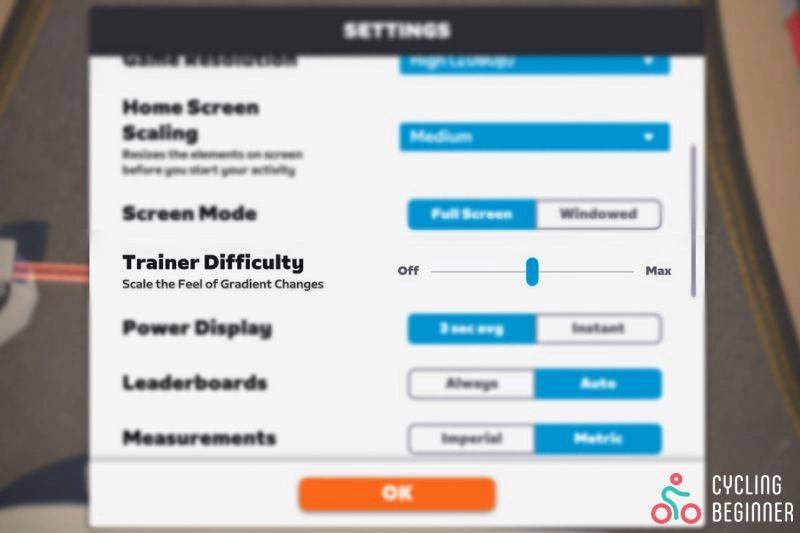Nobody wants to keep switching the cassette from the bike to the trainer and back again. That’s why most of us buy an extra cassette for the trainer. But then there is the question of whether it has to be the same as the one you have on the bike.
You can use a different ratio cassette on the trainer and the bike. The only important thing is that they have the same number of speeds (sprockets) and that the largest cog is the same size or smaller than the largest cog of the cassette on the bike.
Using a cassette with different ratios allows you to cycle normally on a trainer, but you should be aware of a few traps that inexperienced cyclists often fall into.
Looking for the right cassette for your trainer? I suggest the 11-28 cassette, which you can find by clicking here.
Will a different cassette cause me problems?
Not so long ago, I replaced the cassette on my bike with a bigger one. A few months later, I started my indoor season, only to realize that I have a different cassette on a trainer than on a bike. I must admit that I wasn’t sure if it would cause me any problems, but I decided to do my ride anyway.
A good hour later, I had successfully completed the session and remembered that I should have paid attention to any irregularities caused by the cassette. But there were none. If there had been, I’m sure I would not have forgotten after a few minutes that I was using a different cassette from the one on the bike.

This proves that you can easily use cassettes with different ratios on a trainer and a bike, but the cassettes must be similar in three parameters:
- The number of speeds. The cassette on the bike and the cassette on the trainer must have the same sprockets (speeds). If you use an 11-speed cassette on your bike, you must also fit an 11-speed cassette on your trainer. Using a 10-speed or 12-speed cassette will cause problems as the derailleur setting is different, making the shifting non-functional.
- Size of the largest sprocket. Cassettes will differ mainly in the size of the largest sprocket (e.g. 11-28 vs. 11-30). The difference mustn’t be too great, otherwise, the derailleur cage may need to be replaced. It’s also important that the largest cassette sprocket on the trainer is the same size or smaller than the largest cassette sprocket on the bike.
- Manufacturer. Most cassettes are compatible with other manufacturers’ drivetrains, but unfortunately, not all of them. When choosing a cassette for your trainer, you should pay attention to the manufacturer of the cassette (Shimano, SRAM, Campagnolo…) and make sure that it is compatible with the drivetrain on the bike. I recommend you buy a cassette from the same manufacturer as the one you have on your bike.
If all three requirements are met, the different cassette ratios will not be a problem. The rear derailleur, which is the source of the problem when the wrong cassette is selected, works smoothly as long as the size of the cassette matches the length of the cage installed.
Will I have to adjust the derailleur if I use a different cassette?
The biggest fear cyclists have when using a cassette with a different ratio on a trainer is that they would need to readjust the derailleur over and over again.
This fear is completely unnecessary.
There are only two cases where a derailleur adjustment would be necessary. Most people avoid them without even paying attention to them. Nevertheless, it is good to know them, so you can avoid buying the wrong cassette.
The rear derailleur should only be adjusted when the number of speeds is different or when the difference in the size of the largest sprocket is too significant. In both cases, you would need to replace some parts of the derailleur, which would add unnecessary expense.
So make sure you buy the right cassette and you won’t need any derailleur adjustments. However, you will need to calibrate the trainer each time you use a different cassette. If you want to know more about calibration and when it is needed, read the article I wrote.
What is the maximum difference in cassette size?
Before you buy a new cassette and install it on a trainer, it’s good to know what difference you can afford from the cassette on your bike.
Ideally, you would use precisely the same size cassette as you use on your bike. That way, you will avoid any problems, as the derailleur is set up precisely for that size cassette.
However, I understand that indoor cycling differs from riding outside, which is also reflected in using a different cassette.
Ideally, you would use precisely the same size cassette as you use on your bike.
When selecting the cassette for a trainer, the only thing to look out for is that the largest cog is the same size or smaller than the largest cog on the bike. If this condition is met, the difference in size can be up to 7 teeth (e.g. 11-23 vs. 11-30), although such a large difference may lead to less smooth shifting.
I suggest that if you’re buying a smaller cassette, you choose a cassette with two fewer teeth. That way, you will already feel a difference when climbing and you will avoid any problems with the gearbox.
In the table below, you can find information about the compatibility of different cassettes.
| Cassette on bike | Use on a trainer |
|---|---|
| 11-23 | 11-23 |
| 11-25 | 11-25 11-23 12-25 |
| 12-25 | 12-25 |
| 11-28 | 11-28 11-25 11-23 |
| 11-30 (medium cage) | 11-30 11-28 |
| 11-32 (medium cage) | 11-32 11-30 11-28 |
I should point out that an 11-30 cassette already requires a medium cage. As a result, you cannot use this cassette on a trainer if you have a short cage on the bike. For this reason, this cassette is not compatible with smaller cassettes.
You should also pay attention if the cassette has a spacer. Some cassettes have it, which increases the distance between the cogs, meaning the derailleur should be indexed before first use.
Indexing is not too complicated. Just a few turns of the barrel adjuster will do the job. But you would need to index the derailleur every time you switch from bike to trainer and vice versa. Therefore it’s better to buy a cassette without a spacer and avoid unnecessary extra work.
It is best to buy precisely the same cassette to avoid the wrong purchase. This way, the derailleur setting will fit both cassettes, and you’ll be able to switch from the road to the trainer and back again without worries.
Will a different cassette affect my (virtual) climbing?
We use bigger cassettes mainly to make uphill riding easier. The larger the largest cog, the easier it is.
In the virtual world, there are also a lot of climbs where you need the biggest cassette or the strongest legs.
The trainer simulation of incline thus influences the choice of the cassette for the trainer. If it only simulates inclines up to 15%, you may want to choose a slightly smaller cassette, as this will be sufficient for the simulated incline. However, if the trainer simulates more than 20% gradients, then it is wise to choose a larger cassette.
The cassette size should reflect your fitness level and the trainer incline simulation.
The lower the incline simulation, or the fitter you are, the smaller the cassette you need. Conversely, you need a larger cassette if you are less fit or the trainer allows you to simulate higher inclines.
Choosing a smaller cassette will make it harder to ride uphill. Fortunately, virtual cycling apps allow for considerable ride customization, which can make even the steepest hill a breeze.
Adjusting (virtual) shifting on Zwift
Zwift is the leading virtual cycling app. This is also due to the many features that allow almost total customization of your ride. Every hill can be made much easier or completely flattened out. So you can take cassette size entirely out of the equation.
There is an ERG mode in which the route simulation is switched off. It allows you to ride in a single gear as the trainer ensures that the resistance remains the same regardless of the terrain. In this case, it doesn’t matter whether you have a larger or smaller cassette installed.
When using ERG mode, the size of the cassette becomes irrelevant
But the charm of the Zwift is precisely the simulation of climbs. It brings indoor cycling at least a little closer to outdoor riding, which is why few riders swear by ERG mode.
Zwift allows you to adjust your driving beyond ERG mode. You can adjust the “trainer difficulty” anytime to make the ride easier or harder.

The “trainer difficulty” is a function that is initially set to 50% to best mimic riding outside. The difficulty can be lowered if you want a slightly easier ride. The trainer reduces resistance, resulting in easier pedaling to achieve the same power.
Lowering the ‘trainer difficulty’ leads to less need for gear shifting, so the cassette size plays a smaller role. The lower the difficulty setting, the lower the number of sprockets used. And if you only drive in one or two gears, you really don’t need to worry about the size of the largest sprocket.
In most cases riders keep the “trainer difficulty” at 50% to make the experience as close as possible to riding outside.
I don’t change the “trainer difficulty,” as I want the feeling to be as similar as possible to riding outdoors. I also don’t want to give myself a false sense of fitness because if I do, I’ll be in for a harsh spring.

